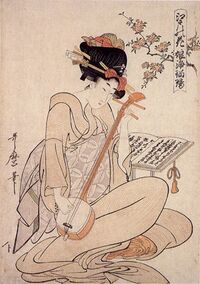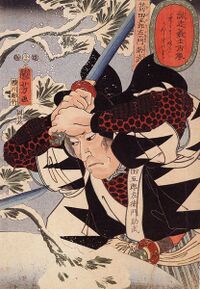Difference between revisions of "Ukiyo-e"
(editing) |
(links) |
||
| Line 1: | Line 1: | ||
*''Japanese'': 浮世絵 ''(ukiyoe)'' | *''Japanese'': 浮世絵 ''(ukiyoe)'' | ||
| − | [[Image:神奈川沖浪裏.jpg|right|300px|thumb|Kanagawaoki Namiura by Katsushika Hokusai]] | + | [[Image:神奈川沖浪裏.jpg|right|300px|thumb|''Kanagawaoki Namiura'' by [[Hokusai|Katsushika Hokusai]]]] |
''Ukiyo-e'' is a genre of Japanese [[painting]] and [[woodblock printing|woodblock prints]], comprising a number of closely related styles, which formed one of the core genres of [[Edo period]] popular art. The term literally means "pictures of the [[floating world]]," and ''ukiyo-e'' images generally depict elements of urban commoner culture, especially [[kabuki]] actors, courtesans and other beautiful women, sumo wrestlers, and [[meisho|famous places]] around [[Edo]] and elsewhere. | ''Ukiyo-e'' is a genre of Japanese [[painting]] and [[woodblock printing|woodblock prints]], comprising a number of closely related styles, which formed one of the core genres of [[Edo period]] popular art. The term literally means "pictures of the [[floating world]]," and ''ukiyo-e'' images generally depict elements of urban commoner culture, especially [[kabuki]] actors, courtesans and other beautiful women, sumo wrestlers, and [[meisho|famous places]] around [[Edo]] and elsewhere. | ||
| Line 9: | Line 9: | ||
==Origins== | ==Origins== | ||
| − | [[Image:見返り美人sm.jpg|right|180px|thumb|Mikaeri Bijin by Hishikawa Moronobu]] | + | [[Image:見返り美人sm.jpg|right|180px|thumb|''Mikaeri [[Bijinga|Bijin]]'' by [[Hishikawa Moronobu]]]] |
''Ukiyo-e'' has its origins in illustrated woodblock printed books, and in so-called "[[genre painting]]s" of urban life. These forms evolved over the course of the 17th century in parallel with other elements of urban culture such as [[kabuki]], the courtesan districts, and various forms of humorous literature. Many of these paintings were by members of the [[Tosa school]] and [[Kano school|Kanô school]] who had turned away from the formalized forms of their official schools to experiment in new forms. [[Iwasa Matabei]] (1578-1650) was one of the foremost producers of "genre paintings" at this time, many of his works depicting samurai with courtesans, kabuki dances, and the like. | ''Ukiyo-e'' has its origins in illustrated woodblock printed books, and in so-called "[[genre painting]]s" of urban life. These forms evolved over the course of the 17th century in parallel with other elements of urban culture such as [[kabuki]], the courtesan districts, and various forms of humorous literature. Many of these paintings were by members of the [[Tosa school]] and [[Kano school|Kanô school]] who had turned away from the formalized forms of their official schools to experiment in new forms. [[Iwasa Matabei]] (1578-1650) was one of the foremost producers of "genre paintings" at this time, many of his works depicting samurai with courtesans, kabuki dances, and the like. | ||
Revision as of 00:56, 30 December 2011
- Japanese: 浮世絵 (ukiyoe)
Ukiyo-e is a genre of Japanese painting and woodblock prints, comprising a number of closely related styles, which formed one of the core genres of Edo period popular art. The term literally means "pictures of the floating world," and ukiyo-e images generally depict elements of urban commoner culture, especially kabuki actors, courtesans and other beautiful women, sumo wrestlers, and famous places around Edo and elsewhere.
One of the key concepts at the heart of the ukiyo-e aesthetic is the ephemeral nature both of the art itself and of its subjects. The notion of the "floating world" speaks primarily of ephemeral, short-lived experiences in the entertainment districts of the city, a beauty and enjoyment which is fleeting. While ukiyo-e paintings remained expensive objects which were meant to be kept and cherished, the nature of the medium of the woodblock print, along with mass production, allowed ukiyo-e prints to be produced and sold quite cheaply. While only the more wealthy merchants, and other elites, could generally afford to commission paintings, prints were available to the general masses. They were collectibles, but also ephemeral souveniers of one's experiences in the theatre or other entertainment districts of the city.
The genre originated in the late 17th century, reached its climax around 100 years later, and continued into the Meiji period, declining and coming to an end shortly after the turn of the 20th century.
Origins
Ukiyo-e has its origins in illustrated woodblock printed books, and in so-called "genre paintings" of urban life. These forms evolved over the course of the 17th century in parallel with other elements of urban culture such as kabuki, the courtesan districts, and various forms of humorous literature. Many of these paintings were by members of the Tosa school and Kanô school who had turned away from the formalized forms of their official schools to experiment in new forms. Iwasa Matabei (1578-1650) was one of the foremost producers of "genre paintings" at this time, many of his works depicting samurai with courtesans, kabuki dances, and the like.
Perhaps the true birth of ukiyo-e can be said to have occurred when works began being produced in considerable numbers in Edo. Though ukiyo-e consists of both paintings and prints, the reproducibility and low cost of woodblock prints are important elements of the genre, based as it was in being a popular art for the commoner masses; thus, the emergence of mass production of woodblock printed books and single-sheet images in this style is generally considered to mark the genre's true beginnings.
Ukiyo-e would continue to develop in the Kamigata area (i.e. Osaka and Kyoto), and would produce its own distinct styles and great masters, but the true core trend of development and prosperity arguably took place in Edo. Throughout the period, Kamigata remained the center for painting and Edo the center for flourishing production of woodblock prints, though both regions of course saw the production of innumerable works in both media. Even today, ukiyo-e at its full height of development is referred to as "Edo-e" (Edo pictures) in the Kamigata region.
Ukiyo-e had its start in Edo, appropriately enough, in the publishing district. There, in the Kanbun era of the Japanese calendar (1661-1673), one artist emerged as the primary producer of erotic images (shunga) for illustrated books in what would come to be known as the ukiyo-e style. As his name is not known, he has come to be known in scholarship as "the Kanbun Master." He was followed roughly a decade later by Hishikawa Moronobu (d. 1694), who may have been his student, Sugimura Jihei (fl.c. 1681-1697), and others, who continued to produce these simple images, primarily of courtesans, dancing girls, and related erotic scenes.
Printmakers such as Yoshida Hanbei (fl.c. 1664-1689) and Nishikawa Sukenobu (1651-1750) produced similar works in Kamigata, leading the genre in Kamigata. Producing thousands of illustrations for over one hundred books, including many by the famous author Ihara Saikaku, both would remain among the most prolific ukiyo-e artists of the entire Edo period.
In both Edo and Kamigata, images were almost exclusively in monochrome black, sometimes with one or two colors used sparingly, primarily oranges and greens. Sometimes sheets would be hand-colored.
It was not until around 1665, however, that the term "ukiyo", written using the characters 浮世 ("floating world"), would appear. Asai Ryôi's Ukiyo monogatari, published around that time, is generally believed to be the earliest use of the word in that way[1]. Previously, ukiyo had been a Buddhist term, written as 憂世 ("world of grief/melancholy") and referring to the Buddhist perception of the material realm as a world of suffering. Buddhism advocated suppressing material desires, and other physical desires, to devote oneself to the quest for spiritual enlightenment; the "floating world" attitude, however, was very nearly the opposite, advocating devotion to appreciation of the fleeting beauty of life. Though somewhat hedonistic, Asai's oft-quoted definitions of the floating world advocate not raucous pursuits of sexual, culinary and other physical pleasures, but the appreciation of the beauty of cherry blossoms, autumn leaves, the moon, and other things in the world of everyday life.
Early 18th century
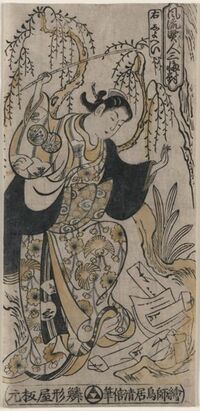
Kabuki actor Torii Kiyomoto and his son Torii Kiyonobu moved to Edo from Osaka in 1687, and produced a great many prints and paintings, primarily as advertisements or promotional souveniers for the kabuki theatre. The Torii school thus founded would continue, under the descendants and students of its members, to dominate the art production of the kabuki theatres through the end of the Edo period.
The school painted primarily signboards and billboards on wood to advertise the theatres' current and upcoming productions, but they also produced single-sheet souvenier prints to be sold to theatregoers. These yakusha-e (actor pictures) depicted kabuki actors either individually or in scenes from the theatre, and would later develop into one of the chief sub-genres of ukiyo-e; it would later become quite common for prints to be made to represent a single given day's production.
Early Torii prints featured many of the same stylistic elements as the works of Moronobu and the others who came before, but made much greater use of the limited numbers of colors available. Though many of these prints used only two or three colors, these would be used quite liberally, and not only as highlights over a primarily monochrome work.

Another school which emerged around this time and which is worth noting is the Kaigetsudô school, founded by Kaigetsudô Ando (c. 1671-1743) in the first decade or so of the 18th century. An exception to the general trend of the genre, the Kaigetsudô artists worked primarily in paintings, not prints, and some never produced prints at all. Their works are typified by hanging scrolls of tall, standing courtesans or beauties in lavishly decorated and brightly colored kimono. Though artists had been painting courtesans and beautiful women since the very beginnings of early proto-ukiyo-e, the works of Ando and his disciples can perhaps be said to represent the true emergence of the sub-genre known as bijinga (pictures of beautiful women).
Kaigetsudô prints generally represented the same subjects, though considerably less colorfully, constrained as they were by the techniques and technology of the time. These works were nevertheless lavish in that they used the technique of urushi-e (lacquer pictures) pioneered by Okumura Masanobu (1686-1764). This style was distinguished by the use of thicker, bolder lines than had typically been used, the application of flecks of brass, bronze, or mica, and the addition of a glue to the inks to help simulate the shine of lacquer.
Miyagawa Chôshun (1683-1753) was among those who drew significant influence from the Kaigetsudô style. Indeed many of his works are bijinga with lavishly ornate and colorful kimono, and a sense of the statuesque. Like several of the Kaigetsudô artists, and unlike the majority of ukiyo-e artists, Chôshun only ever painted, and never produced designs for woodblock prints.
Over the course of the first half of the 18th century, ukiyo-e artists, primarily those of the Torii school, experimented with methods of adding fuller color to their prints. Benizuri-e, or "rose prints", of this period, sometimes featured as many as five different colors - rose, yellow, sienna brown, gray, mustard yellow, and black - but are still marked by a distinctly different appearance and creative technique than the full-color prints which would emerge in 1765.
This period of maturation also saw a diversification of subjects and the development of fuller compositions. One of the key elements to this development is seen in the addition of backgrounds, in other words, context, to what were previously more often than not figures in an empty space, with a minimum of objects or scenery around them. It remained quite common to hand-color prints, and some became as complex in composition as traditional landscape paintings; this represents the origins of landscape as a sub-genre within ukiyo-e, a sub-genre which would flourish in the early 19th century.
Full color
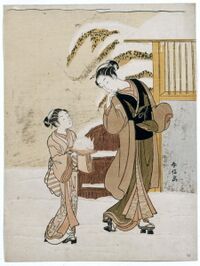
True full-color printing was the result of an innovation by Suzuki Harunobu (c. 1725-1770), who developed the technique, which is called nishiki-e (brocade pictures), only five years before his premature death in 1770. Like many artists of the time, Harunobu was involved in a number of poetry circles, casual social gatherings of artists, actors, writers, connoisseurs and others who would compose poetry together, paint for one another, and generally share their love of art. The first nishiki-e were created as a series of calendar prints for Harunobu's circle. Not displaying a full calendar as one might expect to see today, these were single-sheet prints which incorporated into their imagery the information necessary to know the length of the months for that year. Since the Japanese calendar was lunisolar, which months of the year were long and which short changed each year.
As these were produced for an elite audience and a small distribution solely within Harunobu's circles, they were originally produced using only the finest paper, pigments, and techniques. No expense was spared, and Harunobu set the precedent with his 1765 calendar prints for thicker paper, thicker application of pigments for a more opaque final color result, the shift from catalpa wood to cherry, and perhaps most importantly, the innovative techniques which allowed a full range of colors to be used. A number of blocks would be created for each image, one for each color to be applied, with each block carved to only imprint that portion of the image. With the right equipment, the imprint of each block could be registered perfectly, to line up as many separate blocks, and therefore as many different colors, as desired.
In the five years between the release of these first nishiki-e and his death, Harunobu produced hundreds of works, his unique style showing a marked departure from those of earlier artists. He remains today one of the most famous of all ukiyo-e artists not solely for his innovation, but for his charming and elegant style. In addition to the multitude of innovative elements which nishiki-e techniques allowed, his works are chiefly distinguished by the thin and slight build and young faces of his figures. While most earlier bijinga focused on the allure and sensuality of experienced courtesans, ostensibly full-grown women, Harunobu's bijinga really appealed to the delicate beauty of girlhood. The places and situations represented in his prints also displayed a more everyday, more real, world than many of the prints which came before. Two of his most famous prints, one of a young lady walking past a Shinto shrine, one of the girl Kasamori Osen serving tea at a small outdoor shop, serve as good examples of this real-world aesthetic. He very rarely, if ever, produced actor prints.
Harunobu was followed by a number of disciples and others influenced by his work. Suzuki Harushige, who would later become a master of ranga (Western-style painting) under the name Shiba Kôkan (1747-1818), forged Harunobu's style for several years after the master's death. Ippitsusai Bunchô (fl.c. 1765-1792) and Isoda Kôryûsai (fl.c. 1760s-1780s) were among other notable followers of Harunobu at this time.
Another major innovator, roughly contemporary with Harunobu, was Katsukawa Shunshô (1726-1793) the student of Miyagawa Shunsui (fl.c. 1740s-1760s), son of Miyagawa Chôshun mentioned earlier, and founder of the Katsukawa school.
The Katsukawa school produced both painting and prints, depicting the full range of ukiyo-e subjects, from sumo wrestlers to beauties (bijin). However, it is most known for its actor prints. Rejecting the dominant Torii style, which identified actors only by their crests or not at all, Shunshô contributed to the trend towards greater realism prevalent at the time and produced actor prints which actually reflected the facial features and other distinguishing characteristics of individual actors. He is said to have revitalized the sub-genre, injecting back into it the energy and drama of kabuki, which had gradually drained out of the formerly energetic Torii style over the preceding decades.
Shunshô's student Shunkô (1743-1812) continued his master's tradition and style, and devoted himself more exclusively to actor prints, becoming one of the first to produce large-scale headshot portraits of individual actors. Whereas previous actor prints almost always depicted the full actor, head to toe, and thus represented the role and the costume just as much as the actor, these focused in upon the individual actors' idiosyncrasies and features, becoming true portraits. This form would be continued by many artists after him, including the great masters Sharaku and Utamaro. Katsukawa Shunchô, Shun'ei and Hokusai were among other students of the Katsukawa school.
Maturation
The full-color nishiki-e techniques of Harunobu, combined with Katsukawa Shunshô's shift to more realistic depictions, overturning the dominant forms of the Torii school, opened the doors for further experimentation and individual expression at the end of the 18th century.
Tôshûsai Sharaku (fl.c. 1794-1795), one of the most famous names in the genre, serves as a perfect example of the kind of artist who emerged in this period. Producing prints for an amazingly limited time of only ten months, in 1794-1795, he nevertheless made a huge impact, creating highly distinctive works with a degree of realism not seen before. He expanded upon Shunshô's forms by emphasizing the reality of the actor behind the character; he was among the first and only major Edo artists to represent actors in this way, though it had already long been the dominant form in Kamigata.
While Sharaku focused on headshot portraits of individual actors, Torii Kiyonaga (1752-1815) became head of the Torii school and overhauled its traditional forms, setting the tone for the following century of ukiyo-e in much the same way that his predecessor Torii Kiyonobu did for the 18th century. In a way, his work really represents the culmination of the innovations and stylistic shifts of those who came before him, injecting these into the otherwise staid and static Torii style. His works represent the realism of the Katsukawa school, the delicate grace and brilliant color of Harunobu's work, along with full background scenery. Perhaps the key word to describe his style, and that of much of the 19th century, is "naturalism." Kiyonaga shed the exaggerated and over-dramatic forms of the earlier Torii style, creating scenes in which figures looked and behaved naturalistically, while remaining graceful and beautiful.
Kitagawa Utamaro (1750-1806) was the next major master, dominating the ukiyo-e scene in the 1790s much as Kiyonaga had a decade earlier. He is known primarily for his bijinga portraits, which represent as dramatic and important a shift for that sub-genre as Sharaku's work does for actor prints. Utamaro's works show a strong influence from Kiyonaga, but also a dramatic departure from the bijinga of Harunobu and others; they set a new core standard style for the form. Utamaro's women are more mature-looking than Harunobu's slight figures, more fully-figured and more fully sensual than delicate and graceful. Many of Utamaro's works, including a great number of shunga pieces, seek to represent the life and activity of the courtesans and their district, serving not only as pictures of beautiful women, but as providing a glimpse into their otherwise secret world. Utamaro, along with Kiyonaga and others, was also among the first to make extensive use of the polyptych, images which span multiple individual sheets; while previous artists occasionally produced works in pairs or groups of three, a number of Utamaro's works span six or eight sheets, arranged in two rows. These were sold separately as collectors' items at the time and remain so today.
Utamaro was followed by the Utagawa school, a series of artists who dominated the early 19th century, producing works in a variety of sub-genres. Utagawa Toyoharu (1735-1814), the founder of the school, is cited as the first ukiyo-e artist to truly focus on landscapes and on large group scenes. It was certainly not uncommon for earlier works to include as many as ten or more figures which served as the foreground focus of the work; Toyoharu produced images of tens or hundreds of individuals, incorporated into the landscape, that is, into the scene. Many of these were crowded city scenes, within Edo's kabuki theatres, along its avenues, or on the river.
As such, he was also among the first to incorporate perspective, in the Western style, into his images, rather than simply experimenting with it as a novelty as some earlier artists, as far back as Masanobu and Torii Kiyonobu, had. Those earlier works came to be known as "floating pictures", or uki-e, as the more realistic depiction of depth made the images supposedly seem to float right off the page.
Many of Toyoharu's followers in the Utagawa school, including Utagawa Toyokuni (1769-1825), Toyohiro (1773-1828), Kunisada (1786-1865), Kuniyoshi (1798-1861), and Kunimasa (1773-1810), were famous and talented artists in their own rights, dominating the genre in the early 19th century. They produced a great many bijinga, actor prints, and other works, their style largely imitative of Kiyonaga's, but showing moments of great originality at times.
Katsushika Hokusai (1760-1849) and Andô Hiroshige (1797-1858), easily the two ukiyo-e artists most well-known in the West, thus came quite late in the development of the genre, and, as masters of landscapes, do not truly represent the urban culture (courtesans, actors, and genre scenes) core of the genre.
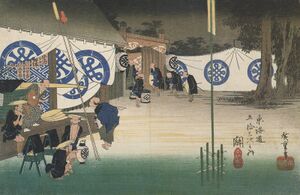
Both of these artists, along with their students and others around them, produced a wide variety of works, both paintings and prints, bijinga, actor prints, images of sumo wrestlers, shunga, and genre scenes, but eventually came to be best known for their landscapes. Their most well-known works, Hokusai's Thirty-Six Views of Mount Fuji and Hiroshige's Fifty-Three Stations of the Tôkaidô, are representative of their landscape work in general, which made extensive use of Western perspective, pigments, and stylistic elements. Though some of these works appear to depart dramatically from ukiyo-e's focus on people and urban scenes, in fact the majority of these pieces are intended to emphasize the people in the prints, within their context; these works also fit quite neatly into a larger trend of Edo period travel literature and artwork, depicting Mt. Fuji, sites along the Tôkaidô road and other famous travel sites. These could serve the collectors either as reminders of the sights they enjoyed on their journeys or, more commonly, as substitutes for those who couldn't or didn't make the journeys at all.
Decline
The Bakumatsu period (c. 1850-1867) and Meiji Restoration of 1868 brought the demise of the Edo period urban culture of which ukiyo-e was a part. The zeal in Japan at the time for Western culture turned artistic attention towards etchings, lithographs, and photographs, spelling the end for the culture of collecting woodblock prints.
One ukiyo-e artist of the Meiji period is worth some attention here. Kobayashi Kiyochika (1847-1915) is often considered the last of the great ukiyo-e artists, working in largely traditional modes and styles despite his often rather modern subjects. The works for which he is most known are those which show the transformation of Edo into Tokyo, and depict traditional scenes with modern elements, such as trains, clocktowers, and horse-drawn carriages.
Later in the Meiji period, woodblock prints (along with photographs and postcards, both first emerging around that time) were used to represent the events of the Sino-Japanese War (1894-1895) and Russo-Japanese War (1904-1905).
A number of other artists of the Meiji period and early 20th century, including most notably Hashiguchi Goyô, Kawase Hasui, Itô Shunsui, and Yoshida Tôshi, adopted more modern and Western methods and styles into their works, and came to comprise what has been called "shin hanga". Meanwhile, painters in the Nihonga style or movement incorporated elements of ukiyo-e style as well.
Though woodblock printing certainly went on for a time after the end of the Edo period, the ukiyo ("floating world") became, for the most part, a thing of the past. Ukiyo-e was very much a product of its time, and continues to represent quite vividly the culture of that time.
Reference
- Lane, Richard. Images from the Floating World. Old Saybrook, CT: Konecky & Konecky, 1978.
- ↑ de Sabato Swinton, Elizabeth. The Women of the Pleasure Quarter. New York: Hudson Hills Press, 1996. p27.


